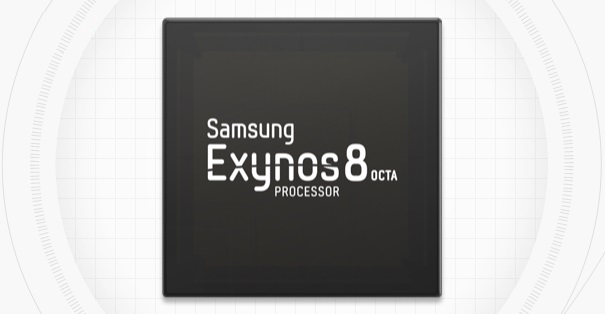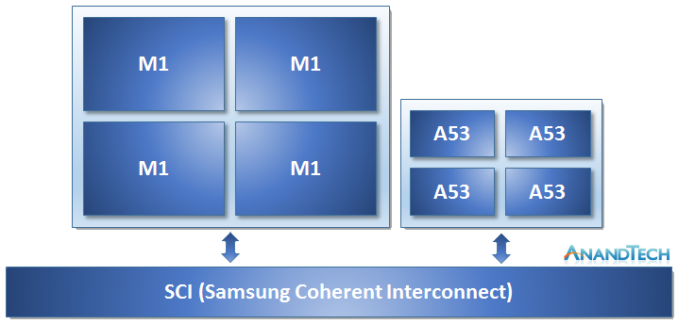Samsung Announces Exynos 8890 with Cat.12/13 Modem and Custom CPU
by Andrei Frumusanu on November 12, 2015 1:50 AM EST- Posted in
- Smartphones
- Samsung
- Mobile
- SoCs
- Exynos 8890
- Exynos M1

In an unexpected and surprise annoucement, Samsung today revealed its new generation flagship SoC - the Exynos 8. The Exynos 8890 to be more specific, is the successor to the Exynos 7420 that we've come to know very well in this year's Galaxy flagships such as the Galaxy S6 or the Note5.
The Exynos 8890 is still an 4+4 big.LITTLE design using four Cortex A53 cores in the little cluster, but on the big cluster we see for the first time Samsung's own custom developed CPU architecture deployed in silicon. The new core, officially called the Exynos M1, is the first fruit of years-long efforts by Samsung's Austin R&D Center to try to create an in-house CPU architecture. What we do know of the M1 is that it's still very similar to ARM's big core architectures (And thus might be a derivative) such as the A72: It's still a 3-wide OoO design with the same amount of execution pipelines and similar, although not quite identical pipeline stages on the execution units.
Samsung follows MediaTek's example by dropping the use of ARM's CCI IP in favour of designing their own cache-coherent interconnect fabric aptly named SCI (Samsung Coherent Interconnect). It seems that vendors are keen to try to improve their SoC architectures by designing fully optimized SoC fabric solutions and I guess Samsung saw the need to differentiate in this regard.
On the GPU side, we see usage of an ARM Mali T880MP12. This is the biggest Mali core implementation to date and increases the number of cores by 50% compared to the Exynos 7420's MP8 configuration. Keeping in mind that the T880 also increases ALU pipelines per core by 50%, we're looking at a 2.25x increase in computational power assuming Samsung kept the clock frequencies equal. Alternatively, they could go lower in frequency for much improved power efficiency. Samsung advertises 4K as an option for this SoC so likely we're looking at a very powerful GPU setup.
Lastly, but not least, is the announcement that the Exynos 8890 is part of Samsung's ModAP lineup, meaning this is a part with a modem. The new modem supports LTE Category 12 download speeds with up to 3x carrier aggregation up to 600Mbps or uploads speeds up to 150Mbps on Cat. 13 with CA. This effectively makes the new Shannon modem on the 8890 equal Qualcomm's Snapdragon 820 modem capabilities. Until further future confirmation on the matter, I fail to use the "integrated" word in regards to the modem due to Samsung's new product page presenting a graphic representing the modem/AP in a way that seems strikingly similar to a SiP (System-in-Package) solution, as opposed to an on-die solution.
The Exynos 8890 is announced to enter mass production in late 2015. With just six weeks left in the calendar year this likely means we're already seeing silicon being etched as we speak, just in time for Samsung's new Galaxy flagship early next year.
Source: Press release











56 Comments
View All Comments
jjj - Thursday, November 12, 2015 - link
The GPU is MP12 ,seen a slide.so rather bananasjjj - Thursday, November 12, 2015 - link
Here the slide http://img1.mydrivers.com/img/20151112/a61e1ad5507...Andrei Frumusanu - Thursday, November 12, 2015 - link
Thanks, tracked it down to their Twitter account: https://twitter.com/SamsungExynos/status/664585940...I updated the article confirming the MP12 configuration.
AciMars - Thursday, November 12, 2015 - link
Just Wow using 12 core of T880... i highly doubt it how samsung can maintain peak performance after 1 minutes heavy gpu load.. LOLlilmoe - Thursday, November 12, 2015 - link
Andrei has a legitimate concern over smaller core counts plus higher frequencies in terms of efficiency and sustained performance. So do I. But throttling and performance degradation is not nearly as severe in real world 3D gaming as they are in 3D benchmarks. Benchmarks like Manhattan push the GPU limits to "unrealistic" amounts. There are simply no games on Android that stress the GPU as much. T-Rex is probably more realistic.What we really need is benchmarking the actual games themselves, and see how throttling and performance are affected over time.
Either way, Samsung is finally going for a wider implementation. That's a great start.
Flunk - Thursday, November 12, 2015 - link
Those games would need to implement a benchmark mode. Android isn't really conducive to using 3rd party programs to test games.Kutark - Sunday, November 15, 2015 - link
Games on android... The mere utterance of the phrase makes me /facepalm...darkich - Sunday, November 15, 2015 - link
The mere utterance of your comment makes me feel sick.Short sighted and ironic beyond belief
OCedHrt - Thursday, November 12, 2015 - link
Article still says MP8.s.yu - Saturday, November 14, 2015 - link
MP12??I remember(though from another source) that Kirin 950 uses MP4 of T880?? This should equate to at least twice of Kirin 950's graphics power then?